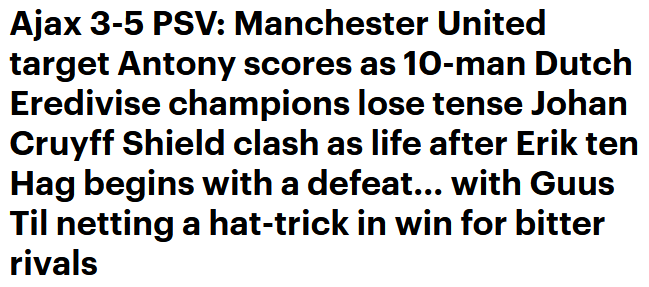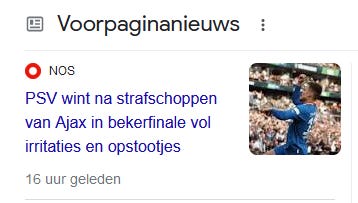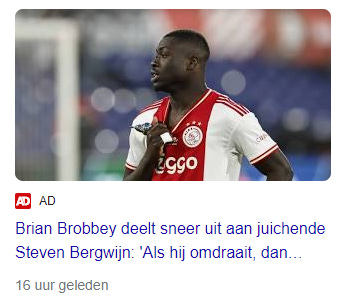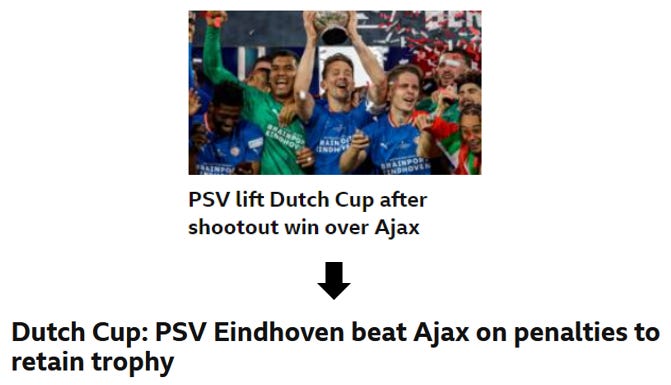The 5 Article Headlines Google Cares About
The 5 Article Headlines Google Cares AboutDid you know that an article can have up to five headlines that each play a different role in Google's ecosystem? This edition will explain it all.Advance notice: The examples I’ve used in this newsletter are not accidental. I am, after all, an Eindhoven-born PSV fan. #Sorrynotsorry As any journalist knows, headlines make stories. Nowhere is this truer than online, where people are bombarded with headlines almost everywhere they look. Crafting a good headline that works on the web is challenging. Headlines that are great for some social media platforms may not perform everywhere, and could tank entirely on search. And headlines that are fully optimised for SEO may not get clicks on social media platforms. This is further complicated by the fact that Google, as the single largest traffic driver to news publishers, takes several different headlines into account for a single article. In fact, I believe there are five headlines an article can have that each play a part in the article’s performance in Google’s ecosystem. 1. Visible HeadlineOf course we start with the visible headline, which is the one shown at the top of a news article. This headline should be the most visually prominent page heading, and ideally is wrapped in a semantic <H1> heading tag.
This headline can be as long and descriptive as you want it to be. Some news publishers like short headlines, whereas others have headlines that are almost a paragraph in length: For your users, this is the main headline. Yet for Google, it’s not actually the most important headline. That honour belongs to the… 2. Structured Data HeadlineThe structured data headline is the value of the ‘headline’ attribute in the article’s structured data markup. The presence of this markup is not a hard requirement, but in my experience articles without some form of Article/NewsArticle/BlogPosting structured data will struggle to perform in Google. The value of the ‘headline’ attribute in this structured data snippet (which should be part of the article’s HTML source) is almost always used by Google as the headline when the article is shown in Top Stories boxes: There used to be a limit of 110 characters on the ‘headline’ attribute in schema structured data, but this is no longer the case. In their article structured data documentation, Google recommends “using a concise title, as long titles may be truncated on some devices.”
Such truncation happens at different points, depending on where and how the article is shown. In most Top Stories boxes, headlines can be between 70 and 85 characters long before there’s a risk of being cut off and you get the ‘…’ at the end: This is a purely visual cut-off. When you look at the HTML source of the Google results page, you’ll see that the entire headline is there. The visual cut-off varies, depending on how the Top Stories box is formatted. The visual limitation is complicated by the fact that the article could also be shown in Google’s ‘ten blue links’ - i.e., the normal non-news search results. However, Google uses a different headline for that: 3. <Title> TagHistorically, a webpage’s <title> tag has been seen as the single most important on-page SEO element. For this reason, it’s often referred to as the ‘SEO title’. For news articles, the <title> tag is less important. It still matters, but it’s not the biggest on-page ranking factor in Google’s news ecosystem. I believe the structured data headline is the most important headline an article can have, as far as ranking in Google’s Top Stories boxes and other news elements goes. But the <title> tag still matters, especially if you have any intention for the article to rank outside of the news cycle in Google’s regular search results. The heading Google shows for a normal search result is based on the <title> tag. As you can see from the example above, there is a visual limit here too - usually around 55 to 65 characters. There is less space available for a heading in Google’s regular search results than there is for article headlines in Top Stories and other news elements. As a result, the recommended length for SEO titles is shorter than for structured data headlines.
So, we have three on-page headlines already. Plenty for Google to choose from, right? Well, actually… 4. Open Graph TitleGoogle Discover is a highly unpredictable traffic source. Many websites get a significant chunk of traffic from Discover, but it’s hard to optimise for. In their official Discover documentation, Google says that articles should use “page titles that capture the essence of the content, but in a non-clickbait fashion.” Yet headlines that are a little clickbait-y work really well in Discover. The Discover feed behaves more like a social media news feed than a search result, so headlines that work well on social also tend to perform on Discover. Google understands this. Anecdotally, I’ve seen Google show article headlines in Discover that don’t match any of the three aforementioned headlines. Instead, Google seems to occasionally pick headlines for Discover from an article’s Open Graph meta tags, specifically the ‘og:title’ tag. I believe this is because Open Graph tags are intended for social media (specifically Facebook, though other networks also use them). And as Discover is more like a social news feed, it makes sense for Google to pick headlines specifically meant for social media. Optimising your Open Graph headlines for maximum clicks on social can also be a contributing factor to success on Discover. In this piece of Publisher Center documentation, og:image meta tags are mentioned as a way to provide images to Google News - so we know Google pays attention to Open Graph meta tags. (Though the accuracy of that piece is questionable; it still refers to the outdated 110 character headline length, and links to deprecated AMP documentation. It obviously hasn’t been updated in a while.) So far we’ve only discussed headlines that are present, in one way or another, in the article itself. Yet there’s one more headline that’s worth optimising, which is the… 5. Internal Link HeadlineWhen an article is shown on a publisher’s homepage or section page, it has a headline too. This headline links to the article itself, and is the method by which Google initially finds the article (as Googlebot finds and crawls links). The text of this headline - the so-called anchor text - is also seen as part of the article’s SEO elements. Google pays attention to the text used to link to a webpage, as this text provides strong clues for the webpage’s topic and relevance. Internal link headlines are frequently subject to length restrictions. News sections are busy, cluttered webpages that have to list many articles while attempting to give each enough space for a strong headline plus, ideally, a good thumbnail image. Using the article’s full headline isn’t always possible, so some publishers define a separate internal link headline which can deviate from the article’s main headline: This gives a publisher more control over how articles are shown on section pages, and introduces opportunities for additional optimisation. So this gives us five headlines for a single article, which could theoretically all be different as they’re all targeting different purposes. There’s actually a 6th headline, but this is closely related to the 5th headline, so you could call it headline 5.5: The in-article link, when an article is linked to from within the text of other articles. Such internal linking for SEO is powerful, and the anchor text used for in-article links carry a lot of SEO value.
SummarisedAn article’s headline is critical to its success in Google. Yet there are in fact five headlines that each play a part, and these could potentially be very different:
Optimising each of these for maximum impact in their proper context can give your publishing site a competitive advantage. There’s limited space for news in Google’s ecosystem, so every opportunity to distinguish yourself from your rivals is worth exploring. If your CMS doesn’t provide options to define these headlines separately, talk to your product team and/or your vendor to see what can be done. MiscellaneaTo wrap up this edition, let’s look at some recent happenings and worthwhile content in SEO and publishing. First, Google has made a few announcements and changes:
In addition to Google’s own prolific output, there’s been a wealth of content published recently which is highly useful, interesting, and valuable for SEO and news publishers:
That’s it for another edition. Thanks so much for reading and subscribing, and stay tuned for the next one! If you liked this article from SEO for Google News, please share it with anyone you think may find it useful. |
Older messages
Integrating SEO into the Newsroom
Wednesday, April 5, 2023
This is a special guest edition of SEO for Google News, where Jessie and Shelby from WTF is SEO write about integrating SEO into newsrooms.
Best Practices for Paywalls and SEO
Tuesday, February 14, 2023
More publishers are exploring subscription models to generate revenue. Paywalls are powerful mechanisms for monetisation, but there are SEO risks involved.
Why Tagging and Categorisation is Critical for News SEO
Tuesday, January 10, 2023
A frequently overlooked yet immensely valuable part of success in news SEO are your content sections and article tags. Let's explore their dos and don'ts in depth.
Sign in to SEO for Google News
Friday, November 11, 2022
Here's a link to sign in to SEO for Google News. This link can only be used once and expires after 24 hours. If expired, please try logging in again here. Sign in now © 2022 Barry Adams City East
The Latest Developments in News SEO
Monday, September 26, 2022
Instead of the usual single-topic exploration, this SFGN edition is a roundup of recent developments and interesting content.
You Might Also Like
eBook & Paperback • Demystifying Hospice: The Secrets to Navigating End-of-Life Care by Barbara Petersen
Monday, March 3, 2025
Author Spots • Kindle • Paperback Welcome to ContentMo's Book of the Day "Barbara
How Homer Simpson's Comical Gluttony Saved Lives
Monday, March 3, 2025
But not Ozzie Smith's. He's still lost, right?
🧙♂️ Why I Ditched Facebook and Thinkific for Circle (Business Deep Dive)
Monday, March 3, 2025
Plus Chad's $50k WIN ͏ ͏ ͏ ͏ ͏ ͏ ͏ ͏ ͏ ͏ ͏ ͏ ͏ ͏ ͏ ͏ ͏ ͏ ͏ ͏ ͏ ͏ ͏ ͏ ͏ ͏ ͏ ͏ ͏ ͏ ͏ ͏ ͏ ͏ ͏ ͏ ͏ ͏ ͏ ͏ ͏ ͏ ͏ ͏ ͏ ͏ ͏ ͏ ͏ ͏ ͏ ͏ ͏ ͏ ͏ ͏ ͏ ͏ ͏ ͏ ͏ ͏ ͏ ͏ ͏ ͏ ͏ ͏ ͏ ͏ ͏ ͏ ͏ ͏ ͏ ͏ ͏ ͏ ͏ ͏ ͏ ͏ ͏ ͏ ͏ ͏ ͏ ͏
I'd like to buy Stripe shares
Monday, March 3, 2025
Hi all, I'm interested in buying Stripe shares. If you know anyone who's interested in selling I'd love an intro. I'm open to buying direct shares or via an SPV (0/0 structure, no
What GenAI is doing to the Content Quality Bell Curve
Monday, March 3, 2025
Generative AI makes it easy to create mediocre content at scale. That means, most of the web will become mediocre content, and you need to work harder to stand out. ͏ ͏ ͏ ͏ ͏ ͏ ͏ ͏ ͏ ͏ ͏ ͏ ͏ ͏ ͏ ͏ ͏ ͏
mRNA breakthrough for cancer treatment, AI of the week, Commitment
Monday, March 3, 2025
A revolutionary mRNA breakthrough could redefine medicine by making treatments more effective, durable, and precise; AI sees major leaps with emotional speech, video generation, and smarter models; and
• Affordable #KU Kindle Unlimited eBook Promos for Writers •
Monday, March 3, 2025
Affordable KU Book Promos "I'm amazed in this day and age there are still people around who treat you so kindly and go the extra mile when you need assistance. If you have any qualms about
The stuff that matters
Sunday, March 2, 2025
Plus, how to build a content library, get clients from social media, and go viral on Substack. ͏ ͏ ͏ ͏ ͏ ͏ ͏ ͏ ͏ ͏ ͏ ͏ ͏ ͏ ͏ ͏ ͏ ͏ ͏ ͏ ͏ ͏ ͏ ͏ ͏ ͏ ͏ ͏ ͏ ͏ ͏ ͏ ͏ ͏ ͏ ͏ ͏ ͏ ͏ ͏ ͏ ͏ ͏ ͏ ͏ ͏ ͏ ͏ ͏ ͏ ͏ ͏ ͏
Food for Agile Thought #482: No Place to Hide from AI, Cagan’s Vision For Product Teams, Distrust Breeds Distrust
Sunday, March 2, 2025
Also: Product Off-Roadmap; AI for PMs; Why Rewrites Fail; GPT 4.5 ͏ ͏ ͏ ͏ ͏ ͏ ͏ ͏ ͏ ͏ ͏ ͏ ͏ ͏ ͏ ͏ ͏ ͏ ͏ ͏ ͏ ͏ ͏ ͏ ͏ ͏ ͏ ͏ ͏ ͏ ͏ ͏ ͏ ͏ ͏ ͏ ͏ ͏ ͏ ͏ ͏ ͏ ͏ ͏ ͏ ͏ ͏ ͏ ͏ ͏ ͏ ͏ ͏ ͏ ͏ ͏ ͏ ͏ ͏ ͏ ͏ ͏ ͏ ͏ ͏ ͏ ͏ ͏
Pinterest For Authors 📌 30 Days of Book Pins 📌 1 Each Day
Sunday, March 2, 2025
"ContentMo is at the top of my promotions list ... "I'm amazed in this day and age there are still people around who treat you so kindly and go the extra mile when you need assistance. If









